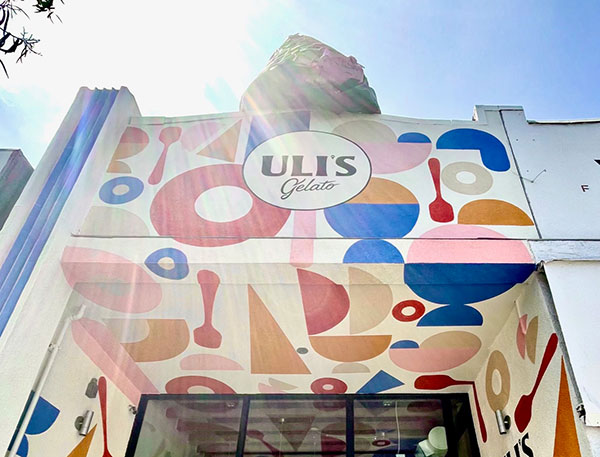*This is content sponsored by DoorDash.
There has been nothing easy about being a restaurant operator during this last year and a half. Through shutdowns, changing customer habits and relentless uncertainty, three self-made owner-operators leaned into delivery and their relationship with DoorDash to find their footing, attract new business and reclaim their love for serving their communities.
While their situations have been uniquely challenging—and still are—they and their teams found the right mix of technology, marketing muscle, innovation and personality can rebuild a restaurant’s bottom line.
A tropical point of light

The Freakin Rican Executive Chef and Founder Derick Lopez
In the heart of Queens, The Freakin Rican was a literal point of light for its community during the first shutdown when most nearby businesses opted to close their doors and literally went dark. The tropical-themed Puerto Rican restaurant was the second restaurant for Executive Chef and Founder Derick Lopez, whose previous restaurant didn’t reach its one-year anniversary.
Lopez and husband, Victor Vargas, launched the new brand at countless New York City street festivals while saving money and waiting for their growing audience to demand a standalone restaurant, which happened in May of 2018.
Looking back, the husband-and-husband duo was grateful for nearly two years of normalcy after their grand opening. Once the pandemic hit and everything changed, they focused on doing what felt right—keeping the doors open and continuing to be a gathering place for one of the most ethnically diverse communities in the world.
“We were the only ones open with the lights on,” Lopez said of those early days. “We were setting the tone for our employees that everything was going to be OK, because they had some normalcy in their life to come to work and do the daily things that they normally would do … and reach out to our audience as much as possible with positive affirmations—we’re big on Instagram and social media, so our community really looks to us for those things.”
Since they were still growing their one-unit restaurant operation when the world changed, The Freakin Rican pushed heavily into delivery orders to maintain volume and continue the critical work of building their customer base.
Early on, a representative from DoorDash stopped by to introduce herself and offer assistance if they had any questions going forward. In an era “when everything is AI and automated,” Lopez said her visit came at the right time and ultimately set the tone for a business partnership that has deepened over time.
The restaurant later was a recipient of a DoorDash Main Street Strong Accelerator grant, and used that financial assistance to expand its outdoor dining area. That program also included eight weeks of expert training, which provided Lopez and Vargas with advice to make the most of their growing delivery and takeout operation.
Their training included networking with restaurant operators across the country who were all going through similar challenges, but at different stages compared to New York, which felt the pandemic earlier and more severely than other parts of the country.
“They’re actually taking the time to give you knowledge that will help you with your business,” Lopez said of DoorDash’s Main Street Strong. “It allowed us to take a step back and look at how other businesses are handling different challenges, and it almost empowers you in a way to find that you’re actually doing a good job.”
Not having to worry so much about attracting new customers, marketing the business and paying an in-house fleet of drivers meant the world as the duo found themselves working extra hours to grow the business and keep their staff employed.
Because dine-in traffic has remained brisk as staffing challenges have grown, their restaurant uses the lowest-cost Basic DoorDash partnership plan, which includes a 6 percent pickup commission and 15 percent delivery commission. That allows them to carefully balance a crowded dining room with a lack of employees for off-premises channels, before selecting a higher tier when they’re ready to receive a higher number of delivery orders, including from DashPass subscribers.
“We don’t want to bite off more than we can chew right now,” Lopez said. “Thankfully we are a very busy restaurant. We’re short-staffed already, and it’s a little chaotic, but hopefully all of this changes and then we can pick a different pricing tier, because we’ll be ready for it.”
Powering past imposter syndrome

Uli Nasibova of Uli’s Gelato
Between Beverly Grove and downtown Los Angeles, Uli Nasibova has a sweet story to tell about combining her passion for gelato with an analytical personality that loves the tinkering and refining that’s inherent in recipe development. She opened her first Uli’s Gelato on the busy Spring Street in Downtown Los Angeles in 2014 and her second Mid-City store on the West 3rd Street corridor in 2017—but it hasn’t been smooth sailing in the four subsequent years as her community and the entire restaurant industry shifted beneath her feet.
“No matter how much research and homework you do—and I did do all of that—you still don’t know what you’re getting into until you’re living it,” Nasibova said, adding that she never second-guessed the decision to open her stores. “I didn’t come from a culinary background and I sometimes had this imposter syndrome because I didn’t spend the last 30 years perfecting this skill, but looking back, that was also my advantage, because I wasn’t going off of preconceived notions of what an ice cream shop should be, I was just doing my own thing.”
Like so many operators in similar circumstances, her business was just hitting its stride with a first-time annual profit, recipes down pat and an excellent crew when the pandemic delivered an immediate, 50-percent hit to gross profits. Because the original model relied almost exclusively on walk-up and dine-in customers, Uli’s Gelato wasn’t prepared for the almost-instant shift to delivery.
“There was a lot going on, so up until the pandemic we just neglected all of that,” she said of the off-premises side of the business. That had to change immediately, which required training employees, sourcing better insulated packaging and a new mindset that changed delivery from a nice-to-have source of extra revenue to an essential component of the growth plan.
Nasibova worked closely with DoorDash, which she said is her only delivery provider where she talks to real human beings “where people reach out to me to make sure that my needs are met and, in my opinion, they’re the only ones listening to the smaller clients like myself.”
After getting up and running with DoorDash Storefront—which allowed Uli’s Gelato to gain full ownership of customer orders with a personalized, commission-free website—a DoorDash representative followed-up to make sure everything was running smoothly. As part of that call, the representative mentioned a new marketing promotion that had been especially successful at other area restaurants, and told her how to go into her account to change her plan settings to unlock lower cost pickup pricing, something Nasibova had missed in an overflowing inbox.
“I was like, ‘Wow, thank you, I didn’t even know this promotion existed,’” she recalled. “Here’s this person proactively reaching out to me saying, ‘Go into your plan settings and select this new setting to switch to 6 percent and that blew my mind. That’s how they get my loyalty and that’s how they’ve gotten me to say I prefer DoorDash to everybody else, because they’ve shown me that they prioritize me.”
She said DoorDash also paid for better product photography, which was a big boost as the entire team wasn’t happy with their previous shots, and the new photos have resonated with both delivery and in-store customers browsing online.
Because of the newly updated features to monitor and respond to customer feedback, Nasibova said it’s incredibly easy to track the impact of ongoing DoorDash promotions, offer discounts to customers who were especially pleased or unhappy with recent experiences, and to keep an eye on which seasonal flavors are selling particularly well.
Uli’s Gelato takes advantage of the Premier pricing plan, which Nasibova selected for the increased visibility that includes a guarantee that restaurants can be refunded for their monthly commission costs if they receive fewer than 20 orders per month, cancel fewer than five orders that month and maintain open hours for 90 percent of the store hours they’ve set in the Merchant Portal—key reassurance in an uncertain time.
“That’s why I picked that plan; I was like, ‘OK, I either pay nothing if I’m not doing so great, but if I am doing great, I get so many more customers or at least so much more exposure to those customers,” she added.
Delivery as a culinary incubator
 After a career as a waitress and bartender, then as director of a nonprofit organization operating concession stands in high-volume venues like Coors Field and Mile High Stadium, Mary McKnabb purchased her first restaurant, Inga’s Alpine Tavern, near the high-end Cherry Creek Denver neighborhood in 2019.
After a career as a waitress and bartender, then as director of a nonprofit organization operating concession stands in high-volume venues like Coors Field and Mile High Stadium, Mary McKnabb purchased her first restaurant, Inga’s Alpine Tavern, near the high-end Cherry Creek Denver neighborhood in 2019.
After losing some customers during the transition to new ownership, Inga’s had its best month ever in February 2020, even beating numbers of the previous owners, and then … “BAM,” as McKnabb put it, everything changed.
“We survived because of third-party deliveries,” she said. “We laid off all the employees, and it was just myself and partners who did all the cooking. We stayed open, we got PPP, whatever assistance was out there, and it was 100% needed.”
Having previously been a Dasher for DoorDash, it was Mary’s first-choice delivery partner because it was also the top provider by volume in the local community. While the restaurant added other delivery providers after the dawn of the pandemic, it doubled down on DoorDash including adding a fully branded Storefront website, which allowed the restaurant to save money and stop paying an outside provider for online ordering functionality.
“Our relationship with DoorDash is great,” she said. “They’re our number one source of income for third-party deliveries, and they were about half of what we were doing during the [worst of] the pandemic, which was phenomenal. Prior to the pandemic, we weren’t even close to these numbers.”
Aside from takeout customers morphing into die-hard delivery customers, McKnabb said one of the biggest shifts has been customers ordering later in the day, which she attributed to people working from home—and also because Inga’s is one of the few full-service restaurants with late-night hours in the area.
The DoorDash Merchant Portal tells her exactly how she and her team are doing, which saves on the busywork of having to look up that information on multiple different websites. The Merchant Portal also includes easy tools to reply to customers and correct anything that may have gone wrong with previous guest experiences, which is especially critical during an ownership transition.
Because of the high volume of orders Inga’s receives through DoorDash, often more than 20 orders per day, McKnabb said the Premier plan is the ideal fit and “well worth our while.” With more than two years of experience as a delivery operator, her favorite aspect is using DoorDash as an incubator to try out new products to see if it’s something the team would want to roll out to in-store diners.
“It allows you to have trial and error with the menu pretty easily,” she said. “You just add it to the portal, the portal is intuitive and user friendly, and you can see if it’s going to work for your restaurant or not. You don’t really even need to go to the other third parties because DoorDash is number one. Without a doubt, we do more business with DoorDash than any other.”




